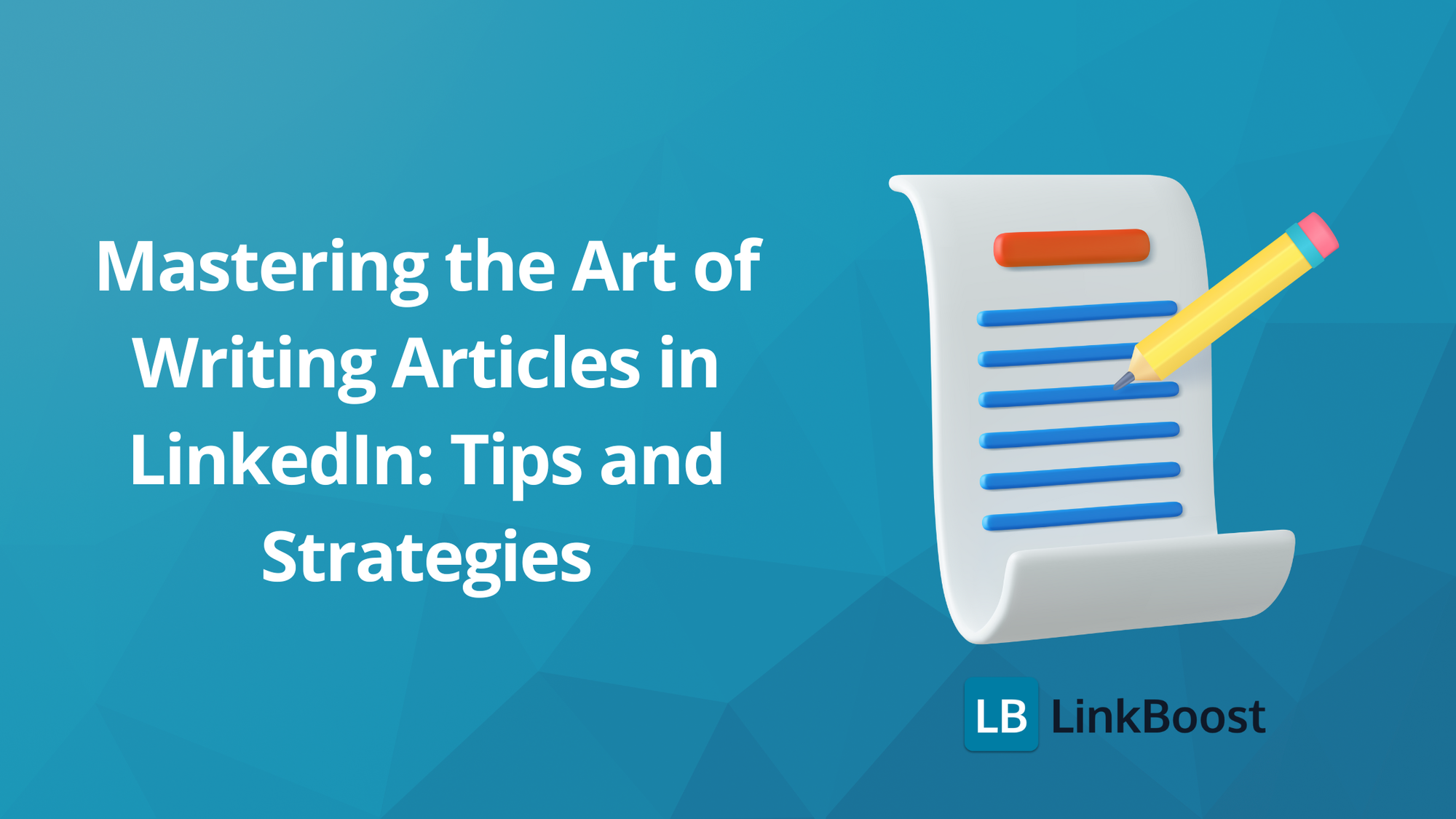Mastering the Art of Writing Articles in LinkedIn: Tips and Strategies

Writing articles in LinkedIn can elevate your professional profile and enhance your credibility. This article will guide you through essential steps to craft compelling LinkedIn articles, including topic selection, keyword optimization, engaging content creation, and effective promotion.

Key Takeaways
- LinkedIn articles allow for in-depth content, enhancing visibility and establishing expertise, unlike regular posts which are limited in length.
- Preparation is key: define your topic, conduct research, and optimize your profile to make your articles resonate with your audience.
- Engagement is crucial; use compelling headlines, a clear structure, rich media, and strong calls to action to boost readability and interaction.
Understanding LinkedIn Articles

LinkedIn articles are a powerful tool for professionals looking to share in-depth content and establish their expertise. Unlike regular LinkedIn posts, which are limited to 1,300 characters, articles allow for much deeper analysis and discussion. They are akin to blog posts, offering a space for comprehensive content that can significantly enhance your visibility and credibility on the platform. Additionally, creating LinkedIn article articles can further showcase your knowledge and insights.
Publishing articles on LinkedIn not only helps you stand out in a crowded content-rich environment but also allows you to grab the attention of a broader audience. Consistently producing high-quality articles demonstrates your expertise, helps grow your network, and can attract new clients or job opportunities.
LinkedIn Articles vs. Posts
While both LinkedIn articles and linkedin post are valuable, they serve different purposes. Regular posts are excellent for quick updates and short insights but are limited in length, which restricts the depth of content you can share. In contrast, articles enable you to delve deeply into topics, providing detailed analysis and thought leadership that can establish you as an expert in your field.
Another key difference is the lifespan of content. Posts quickly get buried in news feeds, while articles remain accessible on your profile, continuing to attract views and engagement over a longer period. This extended visibility makes articles a more strategic choice for sharing substantial content and building a lasting professional presence.
Benefits of Writing LinkedIn Articles
The benefits of writing LinkedIn articles are manifold. Here are some key advantages:
- They significantly increase your visibility on the platform.
- Well-crafted articles can initiate conversations and attract attention, further enhancing your professional reach.
- By frequently publishing articles, you can provide deeper insights into your business or personal brand, helping to build credibility and trust within your network.
Another significant advantage is the potential for external visibility. Articles that rank on Google can attract attention from employers, potential collaborators, and industry peers. This can open up numerous networking opportunities and establish you as a thought leader in your industry, especially if your linkedin articles rank well.
Moreover, writing LinkedIn articles allows you to articulate your brand narrative and connect with like-minded professionals. Sharing valuable content helps build a community around your insights and fosters meaningful discussions that drive professional growth. Ultimately, the consistent creation of informative and engaging articles can lead to long-term benefits, including new connections, opportunities, and enhanced professional credibility.
Preparing to Write Your LinkedIn Article

Before diving into writing articles, preparation is key. Establishing a clear objective, defining your topic, and conducting thorough research are essential steps to ensure your article is well-received and effective.
Planning ensures that your content resonates with your audience and stands out in a crowded space.
Optimizing Your LinkedIn Profile
A well-optimized LinkedIn profile is the foundation of your personal brand. It enhances your visibility and credibility, making it easier for readers to trust and engage with your content. Before publishing any articles, ensure your profile is complete, with a professional photo, detailed work experience, and a compelling summary that highlights your expertise in your personal linkedin feed.
Optimizing your profile improves your chances of being discovered and creates a strong first impression for readers. This is a crucial step in establishing a consistent and professional online presence.
Choosing the Right Topic
Selecting the right topic is critical to the success of your LinkedIn article. Consider what issues are relevant to your industry and what your target audience cares about. Topics that address industry-related problems, provide solutions, or answer frequently asked questions tend to perform well.
Demonstrating thought leadership and expertise is essential when choosing a topic. By focusing on subjects where you have deep knowledge, you can create articles that not only engage your audience but also reinforce your credibility and authority in your field.
Keyword Research for LinkedIn Articles
Keyword research is a vital part of writing LinkedIn articles. By identifying and incorporating relevant keywords, you can improve your article’s visibility on both LinkedIn and search engines like Google. This means more readers will find your content, increasing your reach and impact.
To conduct effective keyword research, start by identifying terms and phrases that your target audience is likely to search for. Incorporate these keywords naturally throughout your article, including in the title and subheadings, to optimize your content for search engines. This strategic use of keywords can significantly boost the visibility and effectiveness of your LinkedIn articles.
Crafting a Compelling LinkedIn Article

Creating a compelling LinkedIn article requires a blend of strong writing skills and thorough research. High-quality content is crucial, as it not only engages readers but also enhances your credibility.
Focusing on well-written content, rather than just meeting a specific word count, ensures your article provides real value to your audience.
Writing an Engaging Headline
The headline is often the first thing readers see, making it a critical component of your article. An engaging headline can entice users to click through and read more. Effective headlines often pose questions or suggest a benefit to the reader, sparking curiosity and interest.
Structuring Your Article
A well-structured article keeps readers engaged from start to finish. Start with a compelling introduction that poses a question or presents a relatable problem. This hooks the reader and sets the stage for the rest of your content.
Break your article into clear sections with subheadings, making it easier for readers to follow along and absorb the information. Use short paragraphs, bullet points, and bold text to highlight key points and improve readability. This approach not only enhances the reader’s experience but also ensures your main messages stand out.
Using Images, Videos, and Rich Media
Incorporating rich media such as images, videos, and infographics can significantly enhance the appeal of your LinkedIn articles. Visuals make your content more engaging and help to illustrate complex points, making it easier for readers to understand and retain information.
When using images, ensure they are relevant and of high quality. Embed relevant images and videos throughout your article to break up the text and maintain reader interest.
Always credit the sources of your visuals and ensure you have permission to use them. This practice not only respects copyright laws but also adds credibility to your content.
Enhancing Readability and Engagement
To maximize the impact of your LinkedIn articles, it’s essential to focus on readability and engagement. Well-formatted articles with short paragraphs, subheadings, and bullet points are easier to read and more likely to be shared.
Including rich media and interactive elements can further boost engagement and reader retention.
Formatting for Easy Reading
Proper formatting is crucial for keeping readers engaged. Use short paragraphs to make your content more digestible and include subheadings to guide readers through your article. Bullet points and bold text can highlight important information, making it stand out and easier to scan.
Incorporating visuals such as images and videos can also enhance readability. These elements break up the text, making your article more visually appealing and engaging. Attention to formatting creates articles that are both informative and enjoyable to read.
Including a Call to Action
A strong call to action (CTA) is essential for driving engagement and building a community around your content. CTAs can take various forms, such as asking readers to share their thoughts in the comments or encouraging them to share the article with their network. This not only increases engagement but also fosters a sense of connection and dialogue with your audience.
Always ensure that your article delivers on the promise of its headline, maintaining reader trust and engagement. Including a compelling CTA sparks conversation and encourages readers to take action, amplifying the impact of your LinkedIn articles.
Publishing and Promoting Your LinkedIn Article

Publishing your article is just the beginning. To maximize its reach and impact, you need to actively promote it across various channels.
Follow these steps to create linkedin articles and promote your linkedin publishing tool effectively.
Publishing Your Article
Click the “Write an Article” button in the LinkedIn Home tab to start publishing your LinkedIn article. This will take you to the linkedin’s publishing platform, where you can write and edit your article using the linkedin mobile app.
Once you’re satisfied with your content, click the “Publish” button to share it with your network. Remember, LinkedIn automatically saves your article as a draft, so you can return to it at any time before publishing.
Sharing Your Article
After publishing, share your article on your personal feed to notify your followers and increase visibility. Additionally, you can share it in LinkedIn messages, groups, and through your email list to reach a broader audience. Including 3 to 4 relevant hashtags and explaining why you’re sharing the article can further boost its reach.
Consider the best times to post based on when your audience is most active. Studies suggest that early mornings and late afternoons are optimal for engagement.
Strategic sharing of your article maximizes its visibility and impact.
Resharing for Extended Reach
Resharing your articles can help leverage their longer lifespan compared to standard posts. To keep your content fresh, consider resharing from different angles. For instance, focus on one key point the first time you share and highlight another aspect in subsequent shares.
This approach not only keeps your content relevant but also engages different segments of your audience. Regularly resharing your articles extends their reach and continues to drive engagement over time.
Analyzing and Improving Article Performance

Analyzing the performance of your LinkedIn articles is crucial for continuous improvement. Utilizing various analytical tools can provide insights into engagement metrics and audience behavior.
This section will guide you on how to use LinkedIn analytics to measure and enhance your article’s impact.
Using LinkedIn Analytics
To access LinkedIn analytics for your articles, navigate to your profile, click on “View My Profile,” scroll to “Articles and Activity,” and select “See All Articles.” LinkedIn provides data points such as impressions, engagement, and viewer demographics, which can help you understand how your articles are performing.
These anecdotes industry insights can guide you in refining your content strategy. For example, if certain topics or formats receive higher engagement, you can focus more on those areas in future articles.
Regularly reviewing analytics allows you to continuously improve your LinkedIn articles and better meet your audience’s needs.
Iterating Based on Feedback
Gathering feedback from your readers is an essential part of the writing process. Qualitative feedback, such as comments and surveys, can provide valuable insights into what resonates with your audience. This feedback can help you refine your content, making it more relevant and engaging for your readers.
The process of iterating on your articles should be ongoing. Continuously incorporating reader suggestions and making improvements enhances the quality of your content and better aligns it with your audience’s expectations. This iterative approach not only improves your writing skills but also ensures that your LinkedIn articles remain fresh and impactful.
Summary
Mastering the art of writing LinkedIn articles involves understanding the platform’s unique advantages, preparing thoroughly, crafting compelling content, enhancing readability, and promoting your work effectively. By following these strategies, you can significantly boost your visibility, establish your expertise, and build a strong professional network. Remember, the key to success lies in consistency and continuous improvement. Keep writing, iterating, and engaging with your audience to make a lasting impact in your industry.
Frequently Asked Questions
What are the main differences between LinkedIn articles and posts?**?
LinkedIn articles are great for in-depth analysis and longer content, while posts are shorter and limited to 1,300 characters. If you're looking to establish thought leadership, articles are the way to go!
How can I optimize my LinkedIn profile before publishing articles?
To optimize your LinkedIn profile before publishing articles, make sure you have a professional photo, a detailed work history, and a compelling summary showcasing your expertise. This boosts your visibility and establishes your credibility!
What are some tips for choosing the right topic for my LinkedIn article?
Choose a topic that resonates with your target audience by addressing their interests and common challenges. This way, you can showcase your expertise and provide real value with your article.
How can I use LinkedIn analytics to improve my articles?
You can boost your articles by diving into LinkedIn analytics to track impressions, engagement, and audience demographics. These insights will help you tailor your content to what resonates most with your readers.
Why is it important to include a call to action in my LinkedIn articles?
Including a call to action in your LinkedIn articles is crucial because it fosters engagement and encourages readers to participate in the conversation, making your content more impactful. It’s not just about sharing information; it’s about building a community around your ideas.

